The Problem: House Sparrows damage or destroy thousands of Tree Swallow, Bluebird, Purple Martin and Chickadee nestings each year.

Many people feel, and we agree, that:
It is better not to have a nest box at all than to have a nest box that raises House Sparrows!
House Sparrow damage to Tree Swallow nestings is a very important issue in Tree Swallow management, one you may need to deal with. House Sparrows are not native to North America. People brought them here from Europe roughly 150 years ago. There are now over 93,000,000 in North America according to Partners in Flight, and they occur almost everywhere people live! And wherever they are found, House Sparrows compete aggressively with our native cavity-nesting birds for nest sites. Sadly, every year House Sparrows kill many thousands of natives, trapping them in their nests and pecking them to death. Just one example is the adult Tree Swallow killed by a House Sparrow in the photo below, taken by Joni James in Indiana.
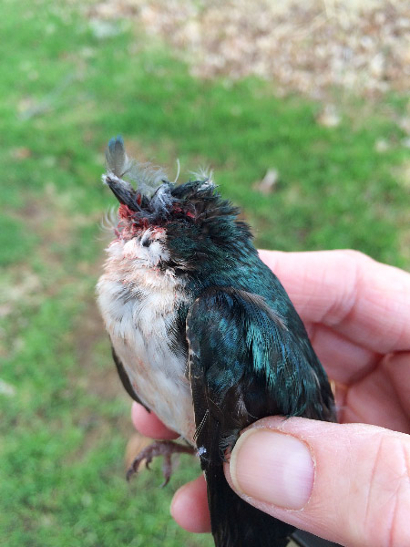
And House Sparrow don’t just kill adult native birds. They killed the four nestling Tree Swallows below inside their nest box in Alberta. Photo by Dick Stauffer.
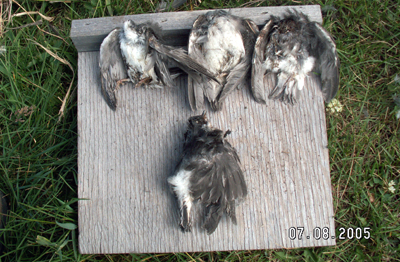
Native birds do try to defend their nests but in the end they usually lose the battle, and sometimes their lives. Photo below of a House Sparrow (left) and a Tree Swallow (right) by Tom Beattie.

Click here for an excellent summary of the House Sparrow problem, written by Kathy Freeze of the Purple Martin Conservation Association.
You must be able to identify House Sparrows to prevent House Sparrow damage to Tree Swallow nestings.
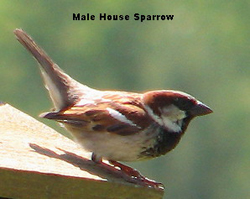
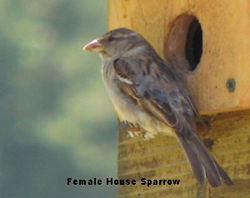
Study the photos above or check a field guide if you aren’t sure what House Sparrows look like. Note that males and females appear different, and please remember, not all small brownish birds are House Sparrows!
What can be done to stop House Sparrow damage to Tree Swallow nestings?
The best source of information concerning dealing with the House Sparrow problem is the bluebird hobbyist web site Sialis. Please check its very comprehensive presentation of issues and tactics of House Sparrow control. We will not try to restate all this material. Instead, we will consider the following two House Sparrow versus Tree Swallow situations:
- How to avoid sparrow destruction of swallow nestings in the FUTURE.
- What to do if sparrows are threatening your swallow nests NOW.
IF House Sparrows destroyed PAST nestings, and you’re worried it could happen again IN THE FUTURE:
- CONSIDER RELOCATING YOUR BOXES TO SAFER LOCATIONS!
- The best way to avoid house sparrow competition is to place swallow boxes far from houses, barns, and other buildings where House Sparrows congregate, at least 100 yards away, preferably much more.
- Don’t add more boxes to “give everyone a chance to nest” because more is not better!
NO box or entrance design will keep House Sparrows out of a Tree Swallow box!
- Many people have tried to design nest boxes that would prevent House Sparrow entry and damage, with little or no success.
- Boxes with small interiors will NOT deter House Sparrows, despite claims. Plus, small interiors can be detrimental or even fatal for young swallows and bluebirds. Click here for a page containing a discussion of nest box size.
- Very small entrance holes will prevent House Sparrows from entering boxes intended for chickadees and some wrens, but will also prevent bluebirds and swallows from using the boxes.
- Slotted entrances, like the Duncraft Swallow Bird House, below, unfortunately do NOT stop all House Sparrows from taking over swallow and bluebird boxes. Tree Swallows, with their slender bodies and small heads, enter these boxes easily. But, although House Sparrows are generally bulkier, in most populations there are individual sparrows that can squeeze through these narrow slots.
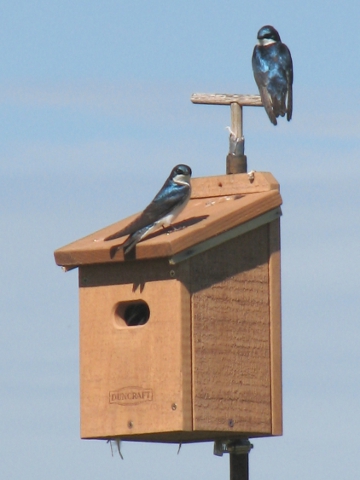
- Slotted entrance restrictors like the one below, have also failed in many cases.
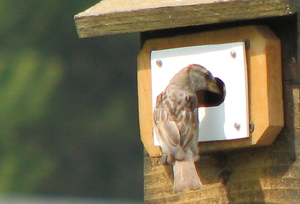
- Therefore, since the destruction of Swallows and Bluebirds by House Sparrows has NOT been solved through box design, we continue to recommend that boxes intended for these native songbirds should be located far from buildings.
IF you have Tree Swallows trying to nest NOW, and House Sparrows are attempting to take over their box:
- Odds are the sparrows will not leave, and it’s only a matter of time before they destroy the swallow nesting.
- Your options are limited: You can kill the House Sparrows, or try non-lethal alternatives such as Sparrow Spookers or Hironbec Pendulums, which we discuss below.
KILLING HOUSE SPARROWS: One option to prevent House Sparrow damage to Tree Swallow nestings.
- House Sparrows are considered non-native pests and, as such, they are NOT protected by law. They can be trapped and killed, or killed outright.
- Methods for trapping and killing House Sparrows can be found on Sialis.
- The same Sialis page also explains why you should NOT relocate House Sparrows.
SPARROW SPOOKERS: A non-lethal option to prevent House Sparrow damage to Tree Swallow nestings.
- If you don’t want to kill House Sparrows you might try a Sparrow Spooker.
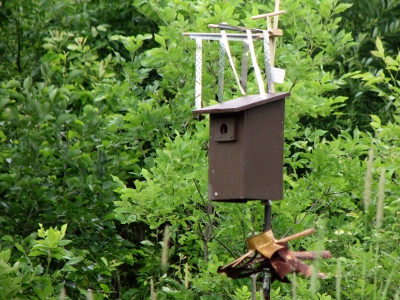
- Sparrow spookers are simple, cheap, easy-to-make devices which can successfully protect Bluebirds from House Sparrows according to Bluebird experts. They should do the same for Tree Swallows.
- Spookers utilize flexible flashing strips, often made of mylar tape sold at garden stores.
- The strips flutter over box lids and entrances, frightening House Sparrows enough to prevent intrusions.
- You can find spooker plans and guidelines on the Sialis web site.
- Bluebirds and Tree Swallows both usually accept spookers on their boxes.
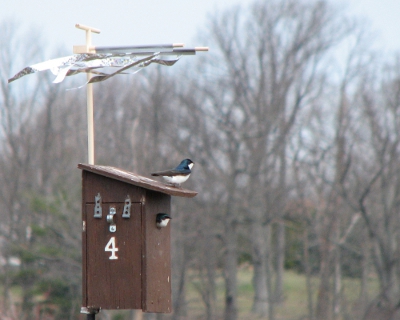
- We conducted a small-scale test that found spookers could prevent House Sparrow damage to Tree Swallow nestings.

MONOFILAMENT FISHING LINE: Another non-lethal House Sparrow deterrent.
- Some persons have found monofilament fishing line arranged on and around nest boxes appears to frighten House Sparrows, but not Tree Swallow or Bluebirds.
- The photo below from Art in Alberta uses thread to show one way to configure fishing line.
- Art emphasizes that to avoid possible entanglements fishing line should be tied on securely, not simply looped around the screws.
- There is a detailed discussion of fishing line use with illustrations on the Sialis website.
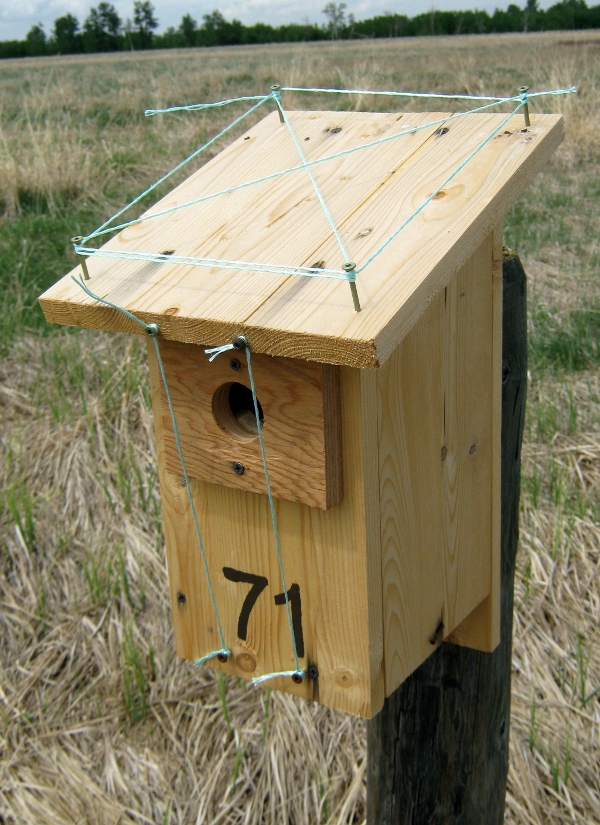
HIRONBEC PENDULUMS: Still another non-lethal option to prevent House Sparrow damage to Tree Swallow nestings.
- Another non-lethal option is the Hironbec Pendulum (see below).
- Rene Lepage of Quebec designed pendulums specifically to protect Tree Swallows from House Sparrows. He’s also the sole vender. Here’s a link to the Hironbec Pendulum website.
- Pendulums are metal devices that attach over nest box entrance holes. They use the weight difference between Tree Swallows, average 20 grams, and House Sparrows, average 28 grams, to prevent sparrows from entering boxes.
- We tested pendulums successfully for several years and offer our own recommendations for their use (see below).
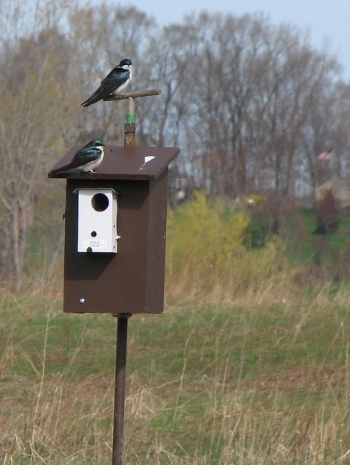
ATTENTION:
- Pendulums are tricky to use and are expensive!
- If you consider buying a pendulum please read this entire section carefully.
- Also, be sure to follow all the links below to get an understanding of what’s involved.
- Read this pdf describing design and operation of the Hironbec Anti-Sparrow Pendulum.
- Watch our YouTube video: “How to Use Hironbec Pendulums to Protect Nesting Tree Swallows from House Sparrows.”
- Read our instructional pdf “Suggestions for Using Hironbec Pendulums to Protect Tree Swallow Nests from House Sparrows.”
How do Pendulums prevent House Sparrow damage to Tree Swallow nestings?
When adjusted correctly a Tree Swallow can land at and pass through a pendulum into a box (below left). But if a House Sparrow lands its heavier weight pivots the pendulum to one side, blocking the box entrance (below right).
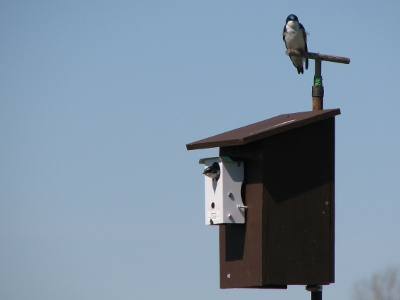
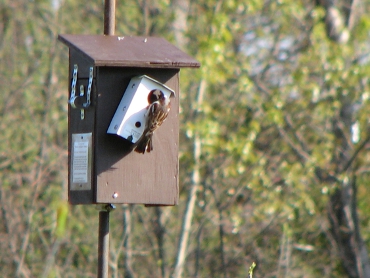
Our Pendulum Trial Results:
- Over four seasons we offered pendulum-equipped boxes twelve times in locations we thought were at risk from House Sparrows.
- Despite this small sample we learned pendulums did protect Tree Swallow nests from House Sparrows when introduced and adjusted correctly, and monitored daily.
- The timing of pendulum-box presentation was very important.
- We had to wait several weeks until female swallows were ready to build nests before we offered them boxes equipped with pendulums.
- During the trials we developed a procedure whereby we “helped” female Tree Swallows learn to pass through pendulums confidently. You can watch this “lesson” in the video mentioned above.
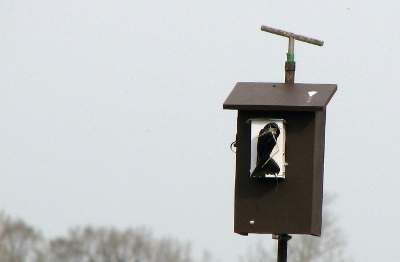
How fast did Tree Swallows learn to use pendulums?
- Generally, females ready and determined to nest-build learned to pass through pendulums very quickly. We assisted during “lessons” by supplying nest grasses, making weight adjustments to the pendulum balance point, and chasing House Sparrows away while the lessons were in progress.
- Once a female Tree Swallow mastered a fully-sensitized pendulum, its tippiness, plus the swallow pair’s nest defense, prevented House Sparrow takeovers.
- House Sparrows ignored pendulum-equipped boxes occupied by swallows after a few days. We think they had found these boxes were unattainable.
- Male swallows learned pendulum operation later while carrying feathers into nests and when feeding nestlings.
- Here’s a YouTube video showing skilled parent Tree Swallows passing through a Pendulum.
- We worried older nestlings near fledging might climb into Pendulums to wait for parents bringing food, and tip out onto the ground. However, nestlings adapted to Pendulum movements, and backed into the box when necessary.
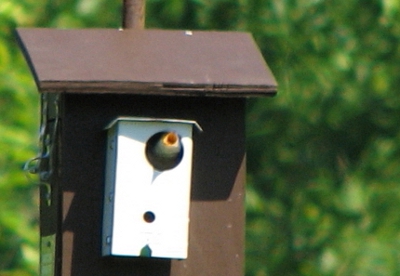
Did pendulums effect Tree Swallow reproductive performance?
- Pendulums did not reduce reproductive performance. We compared the 12 pendulum nestings with 32 nests in a control group of boxes without pendulums. Nest construction, eggs laid, eggs hatched and nestlings fledged did not differ significantly between the groups.
How often do pendulums need to be monitored?
- Pendulums were not something one could set and forget. They had to be monitored to make sure they were correctly positioned and not jammed with feathers or stems (see below).
- As a result, we preferred to monitor pendulums daily to make certain Tree Swallows can enter and exit without problems.
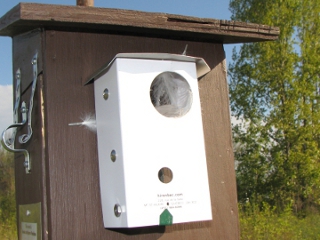
- In conclusion, despite some initial skepticism, we are optimistic pendulums can protect nesting Tree Swallows from House Sparrow intrusions.
- Also, we predict these devices should shield other cavity-nesters like the light-weight Violet-Green Swallow (14 grams). For this reason we encourage folks in the western US and Canada to try pendulums with this species. Photo below by Rob Robinson.
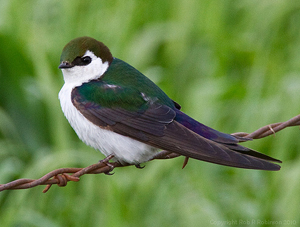
———————————————————————————
Home: Tree Swallow Nest Box Projects
Creating Tree Swallow Nest Box Projects
Spring Return
Nesting Season Behavior
Song and Calls
Nest Site Claiming
Pair Formation
Nest Building
Bird Flight
Mating and Paternity
Diary of One Season at Salmon Creek
Monitoring Nest Boxes and Keeping Records
Making Box Checks Keeping Box Records Control Sheets Season Summaries Print Sheets
Banding Your Tree Swallows Banding Adults Banding Nestlings
Tree Swallows in Research Research Bibliography Glossary of Terms